#the key here is this: observe —> entangle
Explore tagged Tumblr posts
Note
Does the way Edward changed from a bird to a snake indicate his change in character from that point in the story?
Like, at first he was just watching Jacob, being passive to his actions and trying to understand everything, but now J made it more personal? So Ed is no longer just a bird watching, he is a hunter, a snake
...
This turned out much more dramatic than I intended
I just wanted to comment that I found the change of animals interesting! (maybe it doesn't actually have any meaning and I'm just crazy)
Anyway, I love your art 🫶🏽
ding ding ding
#jbsss#jacob black’s self saving system#jacob black#edward cullen#asks#the key here is this: observe —> entangle#a crow and a snake#jake’s perspective of edward shifts but he remains a dead wolf#no way out jake#i have not watched twilight
452 notes
·
View notes
Text
“𝙒𝙝𝙖𝙩𝙚𝙫𝙚𝙧 𝙮𝙤𝙪 𝙙𝙤, 𝙙𝙤𝙣’𝙩 𝙡𝙤𝙤𝙠 𝙙𝙤𝙬𝙣.“



𝖲𝗂𝗀𝗆𝖺 𝗑 𝖦𝖭!𝖱𝖾𝖺𝖽𝖾𝗋 𝗐𝗁𝗈 𝗂𝗌 𝖺𝖿𝗋𝖺𝗂𝖽 𝗈𝖿 𝗁𝖾𝗂𝗀𝗁𝗍𝗌.
𝖶𝖠𝖱𝖭𝖨𝖭𝖦𝖲 ; 𝖭/𝖠 [ 𝖲𝖺𝖿𝖾 𝗍𝗈 𝗋𝖾𝖺𝖽!] 𝖩𝗎𝗌𝗍 𝖿𝗅𝗎𝖿𝖿.
𝘛𝘌𝘙𝘔𝘚; 𝘼𝙘𝙧𝙤𝙥𝙝𝙤𝙗𝙞𝙖 — 𝗧𝗵𝗲 𝗳𝗲𝗮𝗿 𝗼𝗳 𝗵𝗲𝗶𝗴𝗵𝘁𝘀.

• When you first told Sigma that you were afraid of heights, he was a little disappointed but understood that not everyone likes heights like him.
• The disappointment was visible on his face since he would have to make arrangements for you and his hotel room on the Sky Casino. Considering he has a little balcony in the room, Sigma thinks that it might disturb you, even if it wouldn’t. Remember, he wants to please you the best he can since you’re oh so dear to him.
• It wasn’t too much of an issue though, in fact he was happy to at least know just in case you two go on a date anywhere that would be high up.
• The first time he had you stay with him up on the sky casino, you two reached the gate and you immediately started to panic. Sigma could tell that you weren’t okay with this and assured you that it’s alright, and that he’s here to keep you safe.
• Tried to distract you by telling a few things about himself or telling jokes that Nikolai told him, in case the first option didn’t work. His hand on your cheek, directing you to keep looking at him and not to look down. He whispers to you that your alright and won’t fall or anything, telling you to take a deep breath.
• Holds you close when walking you into the Casino so you could calm down. It’s honestly so sweet that he’s doing this, all to keep you from crying or anything.
• When you two get inside and go to your shared room, Sigma asks if you need anything. It could be cuddles, kisses, something to eat or drink just so you can forget the little scare the height caused. It didn’t matter if he had work to do or customers to serve at the moment, your safety and comfort were one of his top priorities.
• Once you assure him you’re okay, he stays a bit before leaving to do other work. When he comes back to the room, expect some kisses, gentle touches, and cuddles.
• The more you two go out the casino and come back in, the more you start to get over your fear and he can definitely see a lot of progress. Sigma praises you for being more comfortable with heights ( Especially since he has a love for heights, Sigma also wishes for you to achieve that same love for heights as well ).
Sigma opens the door with the room key, and as he walks in, his eyes meet yours. A warm smile seen on his face, knowing you’ve make more progress on your acrophobia. “ Sorry I’m a little late, I had a bit of troublesome customers walk in. ” He sighs.
Sigma chuckles before sitting on the bed next to you, feeling your caress his cheek as he leans towards you. Your hands getting entangled with the strands of the white side of his hair. He loved you so much, and this moment felt so perfect. He felt relaxed around you and any stress or worry he had before perished as soon as he sees your beautiful/handsome face. Secretly, Sigma also hopes your worries also go away when you see him.
“ I’ve been observing the progress you’ve been making these past weeks when we enter the Sky Casino. ” He said. “ I want you to know that I’m so proud of you. You’re doing such a good job, please keep it up. ” Sigma finally finished, putting his lips to your forehead and pecking it.
Although Sigma said those words just so you don’t give up on overcoming your fears, he absolutely meant everything that came out of his mouth.
He really was proud of you.

#𝘛𝘩��� 𝘥𝘦𝘴𝘴𝘦𝘳𝘵𝘴 𝘤𝘢𝘭𝘮 𝘵𝘩𝘦 𝘴𝘰𝘶𝘭...🩷#sigma x reader#sigma x you#bsd#bungou stray dogs#bungo stray dogs x reader#bungou sd#bungo sd#bungo stray dogs sigma#sigma bungou stray dogs#sigma#bsd sigma
41 notes
·
View notes
Text
5 Scientific Theories That Align with Spirituality

Science and spirituality may be more connected than we think. Here are five key theories that bridge the gap:
1. Quantum Entanglement
Particles remain instantly connected across distances, supporting the idea of universal interconnectedness.
2. Observer Effect
Quantum physics shows that observation alters reality, echoing spiritual beliefs in manifestation and intention.
3. String Theory
Proposes multiple dimensions, aligning with spiritual teachings about higher planes of existence.
4. Biocentrism
Suggests consciousness creates reality, similar to the spiritual idea that life is an illusion (Maya).
5. Holographic Universe
The theory that reality is a hologram mirrors the belief that everything is interconnected.
Are science and spirituality two sides of the same truth? Let’s discuss! 🔥
#Science & Spirituality Saturday
18 notes
·
View notes
Text
Hello! As late as usual and a bit more frozen than usual! Let's see today's story!

Holmes just wants to do his scrapbooking! He doesn't want a case now! Leave him ALONE!
heyheyhey! This is playing DIRTY!
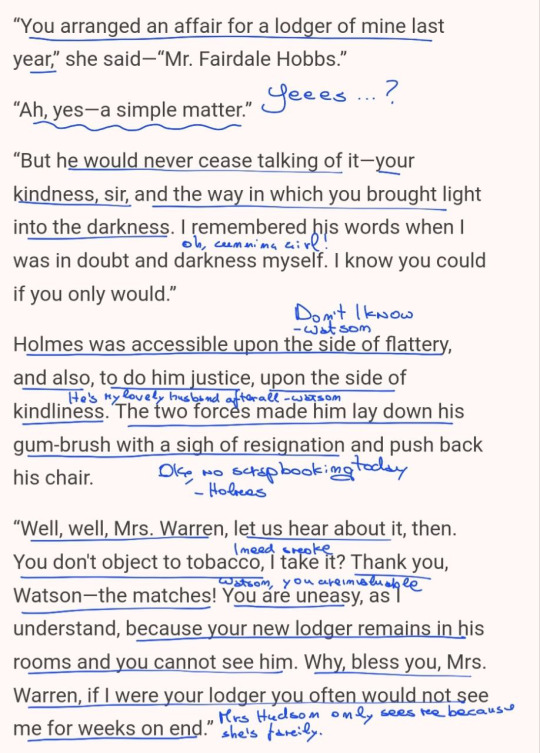
Holmes being quite a bit vain (and this we already knew) and also very very kind. Lol, the comment of not being seen for weeks! Mrs Hudson only sees him on an almost daily basis because she's FAMILY and adopted him! And worries if he doesn't eat his dinner. Well, what's the MATTER with this lodger?
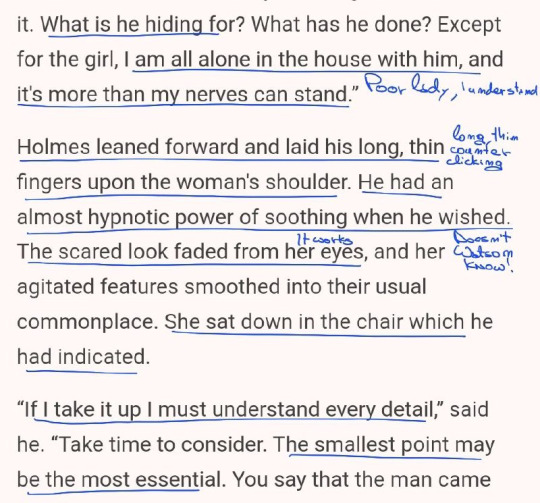
Ah, the landlady is anxious, how to find any fault in it! And who wouldn't be calmed by staring into Holmes' eyes? lol. Bet that Watson speaks also for personal experience (when he has nightmares), for exemple.
Now remember, EVEN THE TINIEST DETAIL!
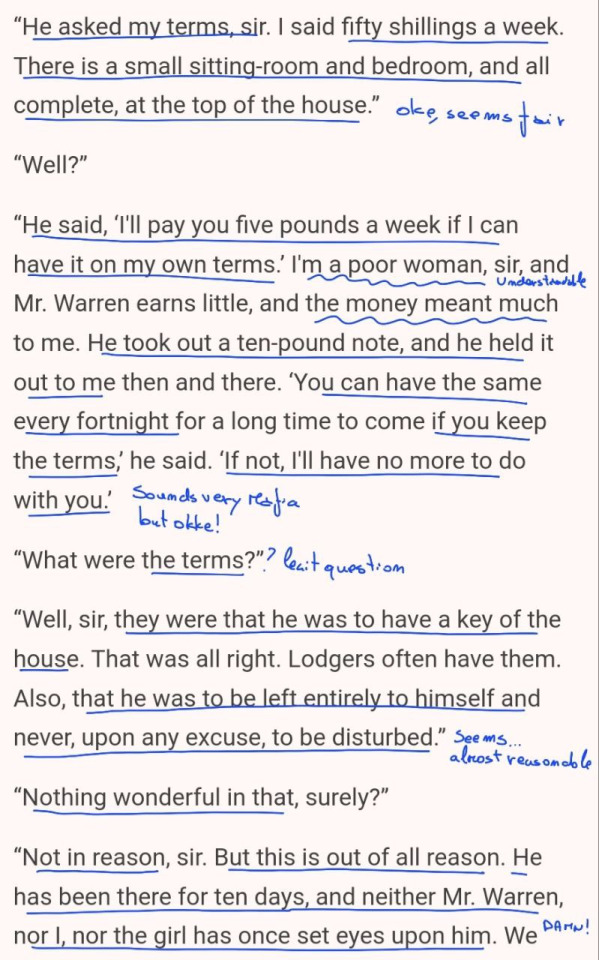
This smells a lot of Mafia, tbh. And usually there is fire when there's smoke. mmmhn we'll see. What about the food? Watson stop glaring
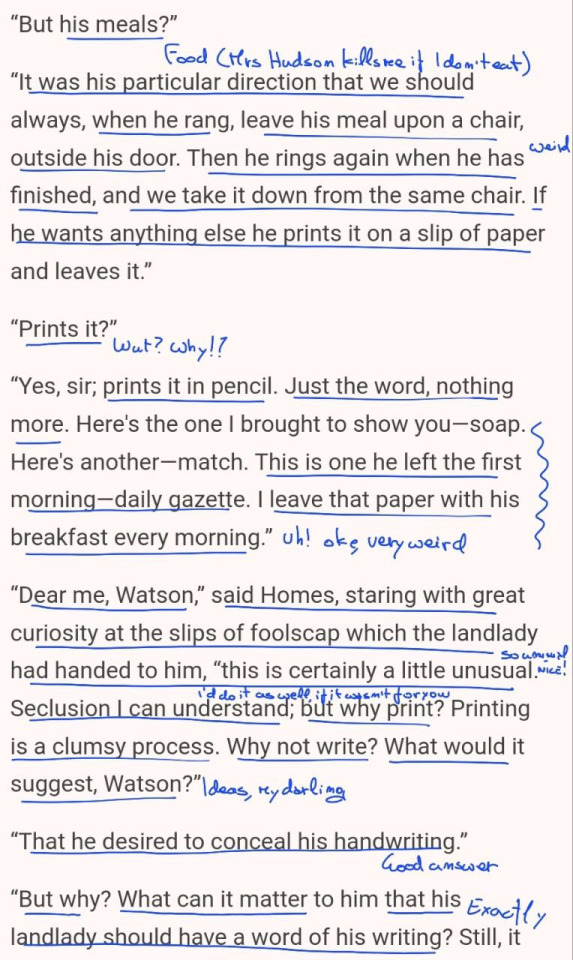
W-why printing? (also guess that printing means not writing in cursive?) This is an actually weird way of communication. Well, the idea of concealing the handwriting is good, tbh but again, WHY. Also, short messages and apparently the lodger seems very cautious. How did he look? this lodger, i mean...
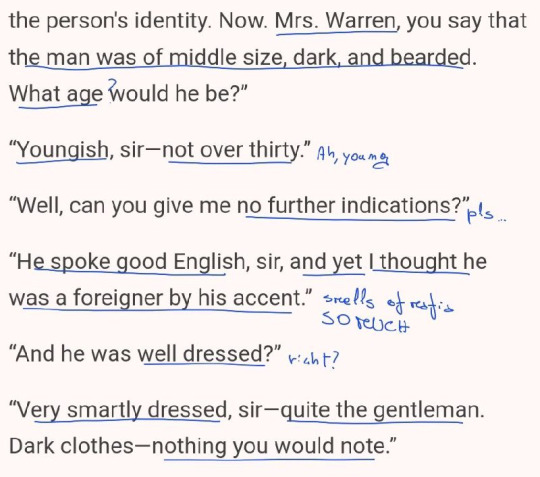
Oh this smells SO MUCH of mafia...
Well, you MUST enter the room in the morning? can't do otherwise!

WATSON STOP GLARING! Looks after himself? WEIRD.
AH! Something to observe, finally!
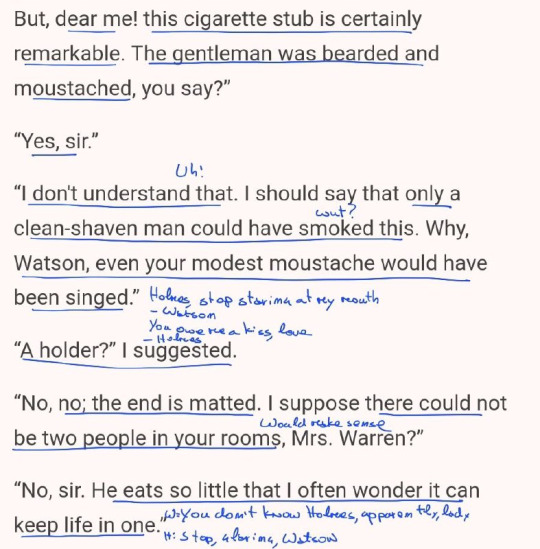
H: He has a beard... but he can't have smoked these! Watson, even with your pretty modest mustache it wouldn't be possible! It would be singed, and it would be such a pity... W: Holmes, stop staring at my mouth, you'll have your kisses. Later H: Alright, alright, spoilsport.
The landlady goes away, Holmes gets his kisses and then back to the analysis!
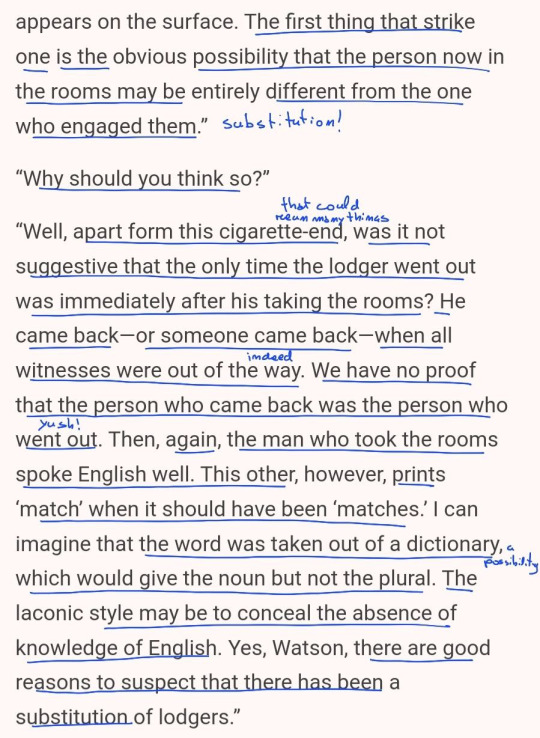
This lodger might not be the bearded man who took the keys! It's an idea. But WHY?
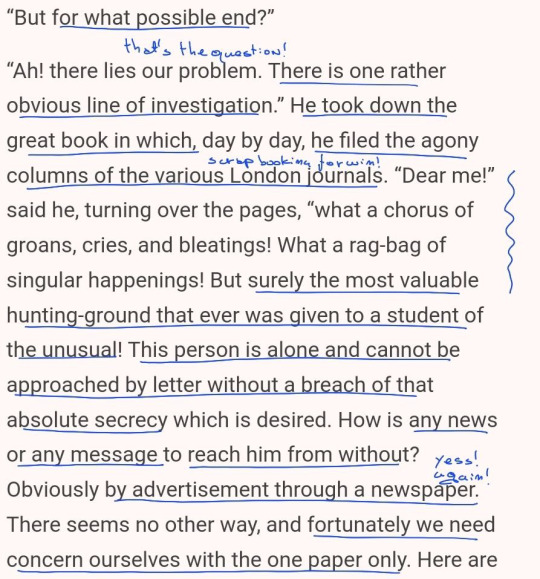
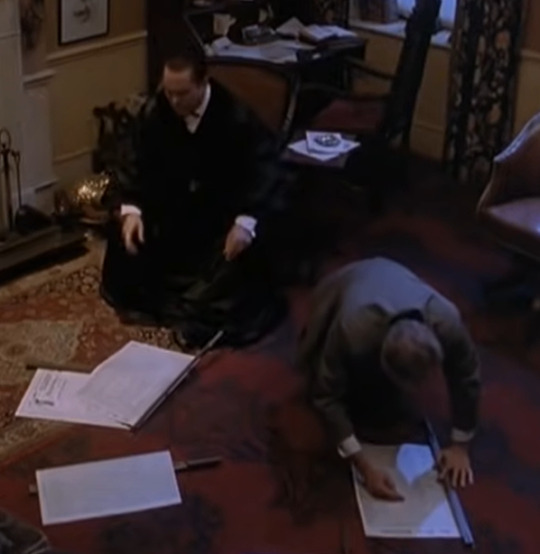
WELL, we can always look in the AGONY COLUMNS! scrapbooking for win! I love how Granada Holmes has his whole little art attack project with the agony columns! He's cute!
AND THEY FIND THE MESSAGES! yahoo! Maybe in the following day's gazette....
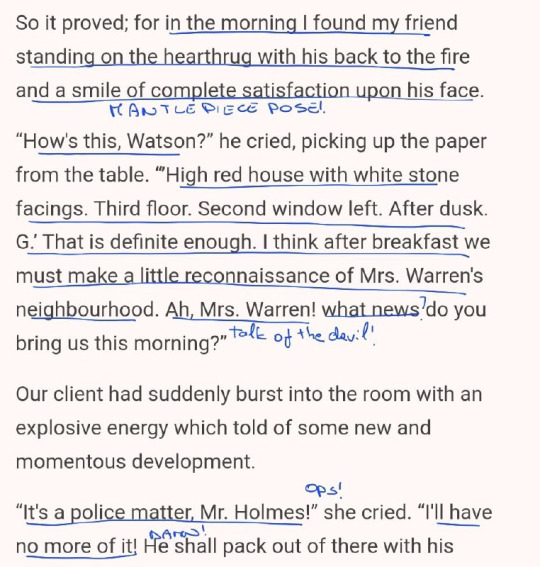
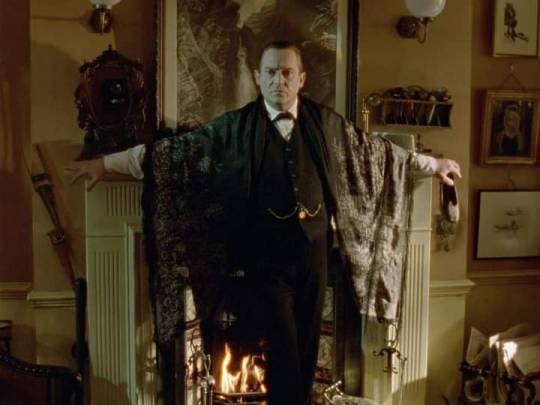
THE MANTLEPIECE POSE! YES! only, Holmes should be happier, but it's alright! Holmes is feeling very satisfied of himself and HEY! CLIENT? What? Hey, they kidnapped her husband... and then let him go? He's shoked? oh damn!
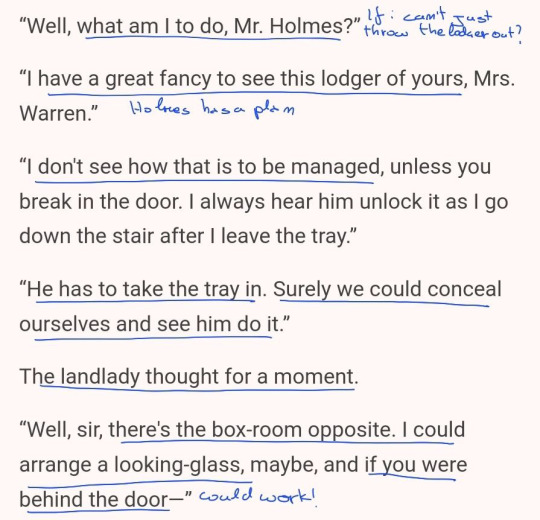
Nice, time to see this guy! Ah you say you can give us a hiding place? NICE! we'll be there!

Uuuuh! Here's the house of the last ad on the paper! Ah, is the hideout ready? yay
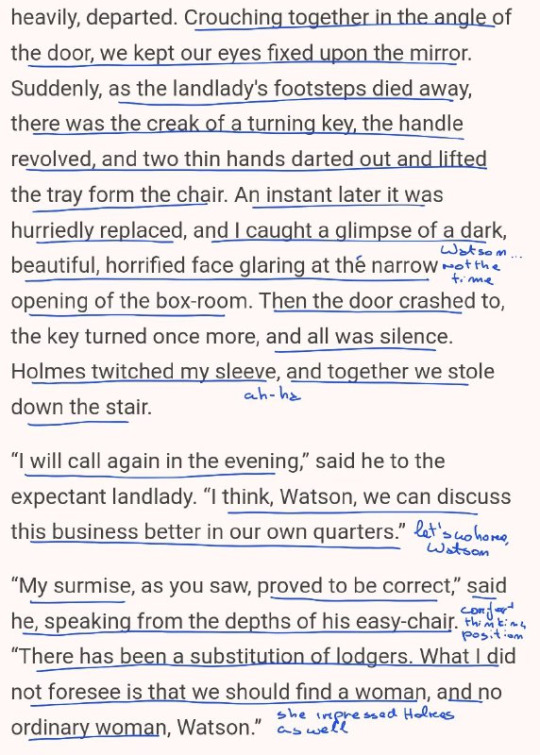
W-what? Oke, the substitution, but... WITH A WOMAN? WOW. And such a woman to impress HOLMES! Stuff to meditate on!
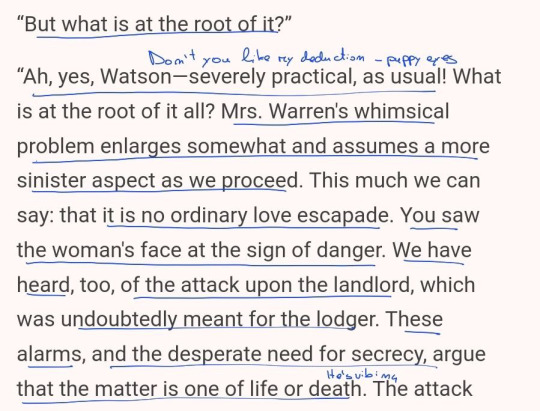
Oh, come on, Watson! I have made a cute deduction! Well, probably she's entangled or well, she and her man are entangled in a matter of life or death! -vibing holmes noises-
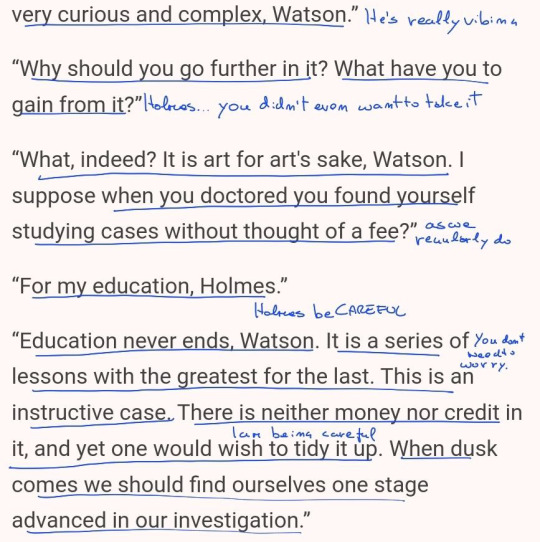
-Holmes is vibing HARDER- While he tells Watson that it's of course l'art pour l'art! (This passage sounds soooo early case! later Watson would know already!)
Evening and they're at the landlady's again! -i'll be very italian now-
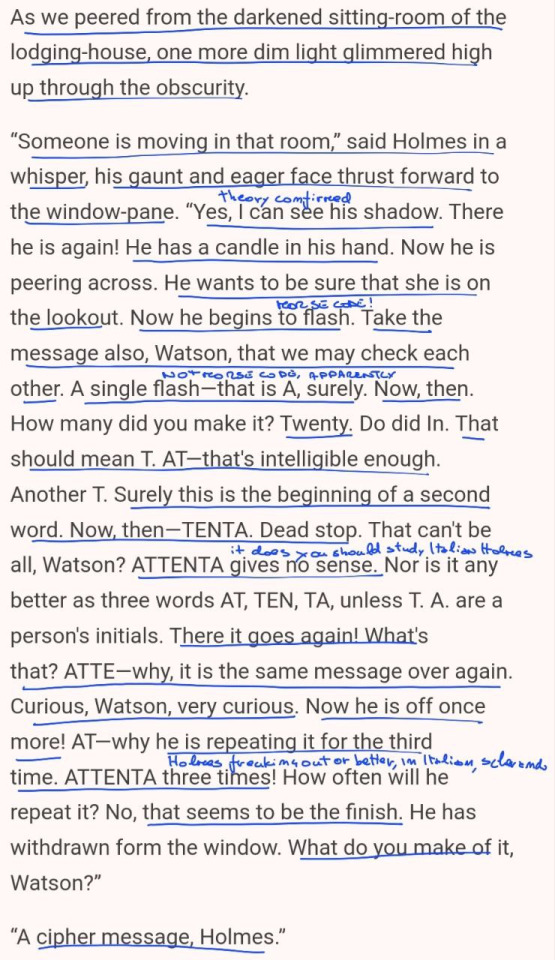
A CODE A CODE A CODE! Eh, Holmes! You should practice your italian a bit more! 'Attenta' means a lot of stuff, as you are freaking out she is understanding (Also the proof that us Italian women as so cool that we even manage to impress Sherlock Holmes uwu) Meanwhile, Holmes sclerandone (sardinian way of speaking) and Watson proposing a cipher and in fact...
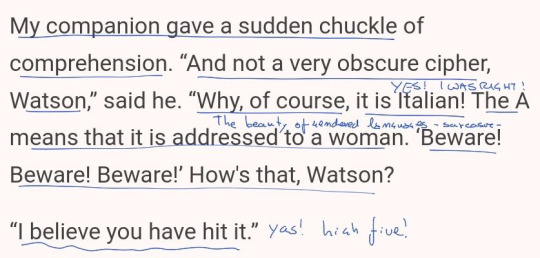
AAAAH! You remember your italian at last! HEY! more messages!

Holmes going 'WTF's happening now?', freaking out a bit more but no Watson, stay with me! (Yes, Holmes 'pericolo' means 'danger', glad you remember your lessons) We're going to investigate now!
And we'll see their discoveries in the next story!
Vibing a lot with the last part in italian! yes!
#letters from watson#victorian husbands#sherlock holmes#dr watson#italian#holmes should practice italian a bit more#italian women are TOP#always known uwu#jeremy brett#unnecessarily handsome#edward hardwicke#the dark side#asexual falling hard for actors from an 80s show
38 notes
·
View notes
Text

Science
Pop Mech Pro: Science
Your Consciousness Can Enter Alternate Dimensions While You’re Dreaming, Scientist Claims
Strong emotions in repetitive dreams could offer cosmic clues about another version of you, according to this controversial idea. By Stav DimitropoulosPublished: Oct 18, 2024 12:52 PM EDT
How many times have you woken up feeling euphoric or deeply disturbed by a dream so vivid it felt indistinguishable from reality? The kind of dream that lingers. Perhaps you notice recurring motifs: specific places, faces, symbols, or even fantastical settings. You are quick to dismiss these as psychological quirks of the brain, and chances are, you will have forgotten about such dreams by midday.
But what if your dreams weren’t just caprices of the sleepy mind? What if they were revealing glimpses into a mirror realm in which your consciousness was wandering? To go even further, perhaps recurring dreams suggest a connection to another reality. For David Leong, Ph.D., an academic specializing in metaphysics and epistemology (the study of distinguishing opinion from justified belief) this might not be just an interesting hypothesis, but the truth.
“Dreams may be windows into distinct realities governed by their laws, in which the mind, unfettered by the constraints of wakefulness, can explore and interact with new forms of existence,” says Leong, an honorary professor at Charisma University in Turks and Caicos.
His hypothesis builds on the Many Worlds interpretation of quantum theory, which suggests that every decision or event creates branching realities—an infinite array of parallel universes. Leong applies this idea to consciousness. He speculates that sleep reduces the influence of our physical senses and rational mind, giving consciousness the freedom to bypass the usual boundaries of time and space. While scientific studies don’t currently support this idea, in Leong’s view, dreams might serve as portals to other versions of ourselves existing in other dimensions.
“AT THE MACROSCOPIC LEVEL, WE ASSUME objects have fixed properties like position or velocity. But quantum experiments challenge this assumption,” Leong explains. The observer effect—where simply observing a quantum system can influence its state—shows that reality is far more fluid than it appears. “Seeing is believing” might hold true in our everyday world, suggests Leong, but at the quantum level, it breaks down, likely shifting according to the observer’s interaction.
In 2022, physicists Alain Aspect, John F. Clauser, and Anton Zeilinger won the Nobel Prize for their groundbreaking work on quantum entanglement. Their experiments challenged the classical notion of local realism—the belief that physical properties exist independently of observation. They demonstrated that particles, even when separated by vast distances, could instantly affect each other. This fact suggests a reality far more interconnected and flexible than scientists previously thought.
Building on their research, Leong explores the concept of “local” and “nonlocal” consciousness. Local consciousness is accountable to our five senses, shaped and sculpted by the body’s sensory input. Nonlocal consciousness, however, transcends the senses, allowing us to experience “broader, interwoven realities,” he says. This concept aligns with speculative ideas such as panpsychism, where awareness is considered a fundamental feature of the universe itself, he says.
Fascinating as this may sound, not all dreams serve as gateways to parallel timelines. Whether dreams return is key here. “Recurring dreams, especially those with vivid and consistent scenarios, might suggest deeper connections to other realities,” Leong claims. On the other hand, dreams tied to personal experiences often feel disjointed, with distorted time. The most surreal and incomprehensible dreams are likely the subconscious processing your life here on Earth, he says. But, if it feels like you’re visiting the dream rather than imagining it—like a play with a beginning, middle, and end—you probably are visiting this other world, under Leong’s hypothesis.
Leong also hints that strong emotions in persistent dreams could offer cosmic clues—signals of how another version of you is experiencing life in a parallel world. “Say you have a repetitive dream of being stuck in high school,” he suggests. “While it may reflect unresolved psychological themes, such as feelings of stagnation or anxiety about personal growth, it could also indicate that in another reality, you are still in high school, dealing with the same challenges your waking self has moved beyond.” This emotional resonance—like the frustration of being stuck—could ripple across dimensions, creating a feedback loop between your conscious mind here and one of your alter egos elsewhere.
YET, AS CAPTIVATING AS THIS HYPOTHESIS MIGHT BE, it runs into a significant problem: there’s no empirical evidence to back it up. Quantum phenomena, such as entanglement and nonlocality, challenge our traditional views on time and space. Yet, no scientific studies conclusively support the idea that dreams are portals to other worlds. Mainstream neuroscience and cognitive science, on the other hand, find this hypothesis heretical—if not downright unscientific.
The activation-synthesis theory, for instance, sees dreams as the brain’s attempt to make sense of random neural activity during the rapid eye movement (REM) stage of sleep. It’s the time when the brain is highly active, colorful dreams occur, and the body experiences temporary muscle paralysis. There’s no evidence of peering into other dimensions whatsoever. Similarly, the memory consolidation theory frames dreams as a tool for organizing daily experiences into long-term memories—not interactions with different selves. The threat simulation theory says dreams serve a survivalist, biological purpose, helping us practice responses to danger—again, there’s no cosmic link.
In addition, almost all of the most prominent schools of modern psychology steer away from metaphysical explanations. Behaviorism, for example, regards dreams as byproducts of learned behaviors, conditioning, or stimuli experienced during waking life, offering no deeper meaning. Some psychologists say dreams are expressions of unresolved conflicts or unintegrated parts of the self. Even the more “liberal” psychoanalysts remain focused on the personal meanings of dreams. Sigmund Freud viewed dreams as the “royal road to the unconscious,” reflecting hidden desires and conflicts. Carl Jung offered a more metaphysical take by proposing that dreams connect us to a collective repository of archetypal experiences shared by all humans. However, he never implied that dreams were gateways to other realities.
Psychologist and physician Dr. Howard Eisenberg explores the intersection of psychology, quantum physics, and consciousness in his book, Dream It to Do It. He suggests that what we perceive as reality might be a collective illusion fueled by Western academia’s blind faith in empirical observation. Generally aligned with Leong’s thinking, Eisenberg argues that perception itself may be responsible for constructing the solidity of our reality.
His argument borrows from the observer effect, which says that observing the world around us is a process that collapses potential realities into one fixed outcome. “In modern quantum mechanics, we no longer view objects as collections of particles but rather as ‘waves of probability,’” Dr. Eisenberg says. There are no physical building blocks, no inherent solidity. Simply put, we—all of us together—created the solids we perceive.
“As strange as this may seem, we are the ones caught in a dreamlike state,” Eisenberg adds.
💡Dig Deeper
Scientists Are Trying to ‘See’ Your Consciousness
Our Consciousness May Come From a Higher Dimension
This Study Backs a Quantum Theory of Consciousness
If dreams truly are doorways to other worlds, they would change the way we live. “Every time you sleep, you wouldn’t just rest—you’d explore. You’d live out alternate versions of yourself, making choices that branch into countless realities,” Leong says. Time would blur across the past, present, and future and across dimensions. Death, too, might lose its finality: “Perhaps you wouldn’t see it as the end, but a transition—another path into a new reality, where consciousness continues to evolve,” he explains.
By logical progression, life itself would feel richer, like a dynamic puzzle of possibilities, pushing us to take risks, explore new paths, and live with the understanding that actions shape not just this life, but infinite versions of ourselves across many realities. Each decision or event could unfold into a fresh act in the ongoing narrative of you. And if one bold or misguided move leads to catastrophe here—well, there would still be countless other dreams to live.

Stav Dimitropoulos
Stav Dimitropoulos’s science writing has appeared online or in print for the BBC, Discover, Scientific American, Nature, Science, Runner’s World, The Daily Beast and others. Stav disrupted an athletic and academic career to become a journalist and get to know the world.
2 notes
·
View notes
Text
The Paradox of the Mind: The Creator and the Deceiver

"Man ke man ke, sab se accha; mann ke man ke, sab se jhooth."
The mind is the best of all; the mind is the greatest liar.
In Sant Kabir’s wisdom, the mind is described as both "the best" and "the greatest liar." This paradox arises from the mind's dual nature. On the one hand, the mind is an extraordinary tool, capable of creativity, deep thought, and insight. It allows us to connect with higher states of consciousness, process spiritual teachings, and experience love, compassion, and wisdom. In this way, the mind is the most powerful instrument for spiritual growth.
However, the mind is also the greatest deceiver. It is prone to illusions, distractions, desires, and attachments. The mind constantly creates stories—about who we are, what we want, and how the world should be. These stories often pull us away from the truth, leading us into suffering. The ego, which feeds on the mind’s narratives, keeps us trapped in cycles of desire, fear, and dissatisfaction. The mind becomes a liar when it convinces us that happiness and fulfillment lie outside of us—in material things, achievements, or external validation.
The Mind as a Gateway to Liberation
Despite its deceptive nature, the mind also has the potential to become a gateway to spiritual liberation. Sant Kabir’s teaching is not to reject the mind, but to master it. When we become aware of the mind’s tendencies and learn to observe its tricks, we begin to transcend its deceptions. The mind can then be purified and aligned with the higher self.
The mind, when disciplined, can become an ally in our spiritual journey. It can be trained to focus on the present moment, cultivate compassion, and release attachments. By shifting from identification with the mind’s stories to observing them with awareness, we begin to uncover the deeper truth that lies beneath the surface. This is where the mind is "the best," as it becomes a tool for self-realization and inner peace.
The Illusions of the Mind: The Root of Suffering
The mind’s greatest deception lies in its creation of duality—the false notion of separation between the self and the world, between ‘me’ and ‘others.’ This duality leads to judgment, conflict, and suffering. The mind constantly compares, competes, and clings to what it perceives as "good" while rejecting what it perceives as "bad." This attachment to duality traps us in the cycle of samsara, the endless wheel of birth, death, and rebirth.
When we believe in the mind’s illusions, we forget our true nature, which is beyond duality. Our spiritual essence is one with the divine, and it transcends the mind’s limited perceptions. Sant Kabir’s doha reminds us that while the mind can be a powerful tool, it is also the source of our deepest delusions.
Dissolving the Mind’s Deceptions: A Path to Freedom
Sant Kabir’s teachings invite us to go beyond the mind, to witness its workings without becoming entangled in its stories. This is the path of self-awareness, where we observe the mind with detachment and clarity. By doing so, we dissolve the illusions of duality, judgment, and ego, and we reconnect with the deeper truth of oneness and divine presence.
The mind’s duality can only be transcended through awareness. This is why Sant Kabir says that the mind is both the best and the greatest liar—because it contains the potential for both liberation and delusion. The key is not to reject the mind but to master it, to use it as a tool for awakening rather than being deceived by its tricks.
A Practical Toolkit for Mastering the Mind’s Dual Nature
To help you integrate the wisdom of Sant Kabir’s doha into your daily life, here’s a practical toolkit to work with the mind’s dual nature, helping you to master it rather than be mastered by it:
Mindfulness Meditation: Start your day with mindfulness meditation. Sit in a quiet place, close your eyes, and focus on your breath. Observe your thoughts as they arise, without judgment or attachment. This practice helps you become aware of the mind’s stories and learn to watch them from a place of stillness, rather than getting caught in them.
Self-Inquiry: Practice self-inquiry by asking yourself, “Who am I beyond the mind’s stories?” This question allows you to go beyond the surface level of thoughts and connect with your true self, which is not defined by the mind’s illusions. The more you ask this question, the more you dissolve the ego’s grip on your consciousness.
Thought Observation: Throughout the day, observe your thoughts. Whenever a judgmental or negative thought arises, pause and ask yourself, “Is this thought serving me? Or is it deceiving me?” This simple act of questioning helps you recognize the mind’s deceptions and choose thoughts that are aligned with your higher self.
Gratitude Practice: Cultivate gratitude to shift your mind from its tendency to focus on what’s lacking to what’s abundant. Each evening, write down three things you are grateful for. This practice helps retrain the mind to focus on positivity, which dissolves many of its deceptions and cultivates peace.
Affirmations: Use positive affirmations to rewire the mind. Affirmations such as “I am more than my thoughts,” “I am connected to divine truth,” or “I choose peace over illusion” can help align the mind with higher states of consciousness. Repeat these affirmations daily, especially when you feel caught in the mind’s traps.
Detachment Practice: Practice detachment by recognizing that not every thought or feeling needs to be acted upon. Just because the mind presents something to you doesn’t mean it’s true or necessary. Learning to detach from your thoughts and emotions allows you to see them for what they are—temporary and often deceptive.
Acts of Compassion: Perform small acts of compassion for others to dissolve the ego’s sense of separation. When you act selflessly, the mind’s duality weakens, and you begin to experience the interconnectedness of all beings.
Daily Reflection: At the end of each day, reflect on moments when your mind was "the best" and when it was "the greatest liar." Celebrate the moments when you were able to transcend the mind’s illusions and be compassionate with yourself in moments when you got caught in them.
By practicing these tools daily, you will begin to experience a shift in your relationship with the mind. Rather than being a slave to its illusions, you will become its master, using the mind as a tool for spiritual awakening and inner peace. Sant Kabir’s doha reminds us that the mind holds both truth and deception—our task is to recognize both and rise above them to discover our true self.
#SantKabirWisdom#Mindfulness#SpiritualGrowth#InnerPeace#MindMastery#EgoDissolution#ConsciousLiving#SelfAwareness#SoulJourney#SpiritualAwakening#MindOverMatter#MentalClarity#ThoughtAwareness#InnerTransformation#DivineInsight#AGImageAI
2 notes
·
View notes
Text
Stranger Things The Bully Review

Synopsis: It’s been a year since Troy had his arm broken by Eleven. Still struggling with nightmares over the encounter, Troy enlists James’s help as he attempts to prove that what happened to him was only a trick. However, as he becomes entangled in events beyond his control, he begins to realize he might be way in over his head........
Observations:
Of all the tie-in comics, books, and graphic novels related to Stranger Things, this is by far my least favorite. I didn’t have high expectations when I first heard what the premise was going to be, and reading it did nothing to endear it to me.
I’ll say right now that the only thing I liked about this graphic novel was the artwork and coloring. This is by the same team that did Stranger Things Zombie Boys and Stranger Things Erica the Great, and it looks amazing. Sadly, that’s all it has going for it because the story, and the main character they chose to focus on, ends up bringing this down.
This will be a short review because there isn’t a lot to talk about. Nothing that takes place here will likely play any important role in season 5, and it's seriously doubtful the Duffer Brothers are bringing back Troy and James for the final season.
The entire time I was reading, there was one persistent thought going through my head: What is the point of this?
I get the comics, graphic novels, and books are meant to expand the world of Stranger Things and flesh-out aspects and characters that the show didn’t have time to focus on, but this particular instance felt pointless and time-consuming. Troy and James are not characters that have appeared since season 1, and they’ve had absolutely no role in driving the plot forward since that time. They were just there to exist as stock bullies who made the main characters lives a living hell (similar to Angela and her ilk from season 4). Once they served their purpose (and got a humiliating comeuppance for their behavior), there was no need for them to be on the show anymore.
So you’d think if they were going to bring those particular characters back, they’d do something meaningful with them. Unfortunately, they don’t.
The story is set during season 2, with the major difference being we get to see it from Troy’s perspective as he witnesses key events: Will getting bullied on Halloween Night and (unbeknownst to Troy) hallucinating the Mind Flayer, the pollywogs, the rotten pumpkin patch, the demodogs attack in the junkyard, and so on. Troy and James basically act as observers during all of this.
It’s a similar premise to the Stranger Things Summer Special comic that came out last year: It rehashes the events of a certain season, except they stick in unimportant side characters who coincidentally happened to be there when those events were taking place. The difference is the Summer Special focused on Officers Callahan and Powell and was set during season 3.
Like Callahan and Powell in the Summer Special, Troy and James don't have a purpose here. You could cut all of their scenes in The Bully, and it would have no impact on the overall plot of season 2.
It doesn't help that Troy is extremely unlikable during all of this. If you despised him in season 1, you're not going to think any better of him here. He spends most of the story being an asshole, continues to harass Mike and his friends (and at one point is about to slash their bike tires out of sheer spite), throws rocks at squirrels because he can, and repeatedly treats James like shit (to the point James starts to get fed up with him).


They try to give Troy a Freudian Excuse in the form of his parents (similar to what they did with Billy on the show) with Troy's mom being a Karen and Troy's dad being one of those "Don't Apologize, It Shows Weakness" type of guys. However, it still doesn't do anything to make Troy likeable because the problem is Troy doesn't have any other redeeming qualities to fall back on. He's still a bully, and whatever measly attempts there are to make him look sympathetic fall flat. I remember this was discussed on the Stranger Things TV Tropes page at one point when someone tried to put Troy in the "Unintentionally Sympathetic" category, rationalizing that it's hard not to feel bad for him even if he's irredeemable, to which other users pointed out that since Troy is irredeemable, he isn't sympathetic.
The ending is where the graphic novel completely falls apart. Long story short, Troy and James end up near the same junkyard the night Steve is fighting off the demodogs to protect Dustin, Lucas, and Max on the bus. Despite James's meek suggestion that maybe they should go help Steve and the others (brownie points for that I guess?), Troy flat-out refuses. Both Troy and James later get chased by demodogs, and James ends up tripping and falling down as one of the demodogs closes in on him. Troy initially looks like he's going to help James, but chooses to save his own skin instead. Just when the demodogs are about to attack them, the Mind Flayer calls them back to raid Hawkins Lab. In the aftermath, Troy begins berating James again, and James finally reaches his limit with Troy, gives him a scathing "Reason You Suck" speech, and leaves. The next day, just before Troy is set to move out of Hawkins with his parents (because his dad lost his job), he goes to apologize to James and they briefly reconcile before Troy heads out.
Putting aside how the ending glosses over the severity of Troy leaving James to the mercy of the demodogs and expecting us to buy that James would ever want to be his friend again after that, the biggest problem is the moment doesn't feel earned. You can't spend 99% of a story having your main character be this awful, have him do the bare minimum to make up for it, and still expect the readers to care about him.
It doesn't help that this small, pathetic reconciliation Troy has with James doesn’t address the issues audiences had with Troy in the first place. Fans were angry and disgusted with him because of things he'd done on the show: Bullying Mike and his friends, making homophobic (and in Lucas's case, racist) remarks towards them, mocking Will's death when it supposedly happened, and threatening to cut out Dustin's teeth with a knife if Mike didn't walk off a cliff that would have inevitably led to Mike's death had El not intervened. They made Troy too much of a Hate Sink to the point it's borderline impossible to make him redeemable, and this graphic novel does nothing to alleviate that.
If Troy's story had been about realizing how awful of a person he'd become and making a genuine attempt to atone for his treatment of the Party, from apologizing to them to putting in the hard effort of making amends and maybe even trying to become their friends (similar to the arc Steve had in the first 2 seasons), that would be one thing. I don't know how many people would have bought it or cared, but there would have at least been a purpose in that. It would have given Troy some much needed character development, and it would have added depth to a character who was pretty one-dimensional to begin with. But the way it's done here doesn't work. It also doesn't help that other comics (like Zombie Boys and Dungeons and Dragons) demonstrate that Troy really hasn't changed and is still the same bully he's always been:

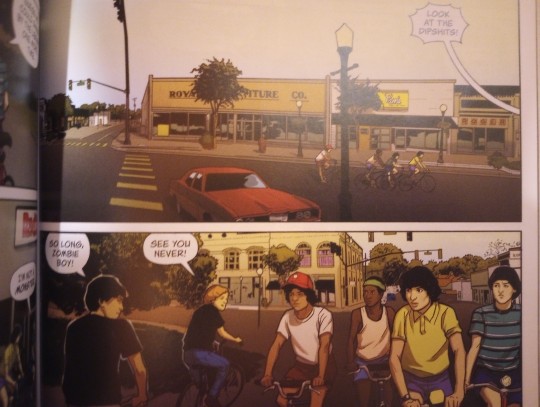
Imagine if they came out with a comic or graphic novel centered around Angela from season 4 that had Angela continue to be a vicious bully to others (even after El smashed her face in with a roller-skate), gave her a flimsy sob story to justify her cruel behavior (which would do absolutely nothing to make her look sympathetic), enlisted her friends to get revenge on El by following her all the way to Hawkins, consistently treated her boyfriend Jake like shit during all of this, ran afoul of Vecna's monsters by chance and proceeded to abandon her friends to save herself like the coward she is, and then offered a measly "I'm sorry" to them later which would get treated as a heartwarming moment. All the while, Angela would have no further role in the show and wouldn't ever appear in season 5.
Would anyone care about this story? Would there be any point to this? Would it change anything about how awful of a person Angela is?
If your answer to these questions is a resounding NO, then you can understand the issues I have with The Bully.
I wouldn't recommend this graphic novel. It's a shame because, as I said before, the artwork and coloring is pretty, but that arguably makes it worse. At least with the Summer Special starring Officers Callahan and Powell, it was a one-shot comic that's currently available on Kindle for a low price. This graphic novel clearly had effort put into it, it's pretty pricey to buy, and the result only highlights just how mediocre and inconsequential it is.
And to be clear: I've liked other graphic novels Greg Pak has written (Zombie Boys is one of my favorites). I don't know if this was a story he decided to write, or if it was mandated from the higher-ups at Netflix and/or Dark Horse, but either way, it's a major miss.
#stranger things#stranger things the bully#stranger things comics#troy walsh#james dante#stranger things season 2#mike wheeler#will byers#lucas sinclair#dustin henderson#steve harrington#demodogs#tgh opinions#tgh reviews#the duffer brothers#angela stranger things
23 notes
·
View notes
Text
What is the collage of design*anthropology*(future)
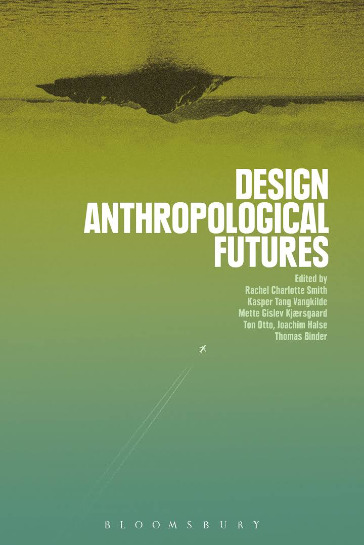
Otto, Binder, T., Halse, J., Smith, R. C., Vangkilde, K. T., & Kjaersgaard, M. G. (2016). Design anthropological futures: exploring emergence, intervention and formation. Bloomsbury. Recommended by Bow since she has "70% confidence" that design anthropology is relevant to my research.
How to understand design anthropology? What is the relevancy to my research?
In fact, I've been interested in design anthropology since the beginning of my PhD study, and has done a little (2 days) research on its evolution as part of my assignment for Design Research Methodologies subject. My impression from the research is that Design Anthropology mainly originated from anthropology, not design. It can be seen as an effort for post-colonial anthropologists who struggle with their identity to turn its orientation from the past to the future, from the exotic and foreign to the becoming self. Design served more as an inspiration and a model of future facing discipline.
But what is the design part, if we are not talking about an anthoropology (or ethnography really) of design practice? Yes, designers can do ethnography, but can it be called anthropology, which touches more theoretical and foundamental aspects of life and living? Or, do "anthropologists of the present" design?
It is with these questions that I turned to the book Design Anthropological Futures, recommended to Bow. This second encounter has reflected how my thought has changed in about one year's time.
On page 4, a quote immediately cought my attention:
"In some cases, historicity (note: anthropology, cartography) becomes a key to reconfiguring futuring, the everyday (note: ethnography) serves as a lab for experimentation, intervention (note: design, futuring, worlding" becomes a path of speculative inquiry (note: futuring), and the environment (note: situatedness, assemblage, milieu) emerges as a philosophical agent"
(Notes in brankets are my own association to other concpets)
Design anthropology therefore takes an evolutionary, process perspective which grounds interventions in its historicity and situatedness, zoom in the milieu where possibilities are emerging. The current, everyday and routine practices are given full attention for their intricate but significant linkage to the future.
This leads to two further questions:
1: How to balance the role between anthropologist (observer; theory heavy) and designer (action-taker; practice heavy)? How do subjectivity and ego play a role in this balancing? (I'm particularly looking for what interventions are discussed here, are they pre-planned or spontaneous?) If we follow the thoughts on agency in a flow, then there is no "interventions" as significant events. The intervention becomes a constant flow, coupling and entanglement.
2: What is the knowledge generated in design anthropology? Is it a static image of explanation, or is it for change? How can it be valuable both for theory and / or practice?
The emerging transdisciplinary field of design anthropology rightfully noticed the similarity between design anthropology and constructive design research, both as action research methods wit its interventionist approach. What differs these from change/activist style of action research is its speculative stance. Design action researchers go into action without a conviction that "this is the right thing to do". Their postures are tentative and curious. The interventions are where the virtual and the actual (in a deleuzian sense) confluences, with each encounter render some tendencies not possible (yet) (either in the self-sensoring in the head of the interventionst, or in form of failures), while in the same time each sparks contingencies and specificites which ignites new possibilities. Thus interventions constantly expand the "possibility space".
That is for the "design" part. As for "anthropology" part, the authors ask, "can the particular staging of possibilities be seen as a new mode of ethnographic inquiry into people's concerns, aspirations and imaginative horizons" (page 7)? I like the words "staging of possibilities", and think this staging and archiving can well go beyond ethnogrpahy.
What is the use of these staged possibilities, after all, if and particularly as they may be not feasible for actualization yet? After all, one of my long-term complaint about various speculative design practices is their obsession with "shock" and "novelty", to a degree that they almost become entertaining (not unlike apoclyptic Hollywood movies). This concern is echoed by the authors too, as they point out that "speculative thinking is fraught with the temptation to lose sight of concrete limitations and constraints, or to gloss over very real controversis and conflicting view points" (page 8). On a positive note, if we remind ourselves that our agencies are not deterministic, rather it form feedbacks and diffractions with a certain assemblage, then we realise the potential this "possibility space" has for de/reterritorialization. They may not be tracable, but are contributors to dependent origination nevertheless.
And then the questions is, how we can encourage this de/reterritorialization? Education is one of the ways but certainly not the only one. This knowing of "whatever I do will create ripples in the world" somehow gave me courage to be more outspoken, to put my "naivety" or "idealism" out there. Like this post - who know where it will travel to.
Design anthropology therefore for me is this narrative including both a cartography of the past to the ethnography of the emerging future (possibilities). The book dedicated one section on the interventionist approach and views each contribution as experimental method of this emerging methodology. Of the 3 or 4 chapters, one is art practice, the other the running of design school at hard times*. I would say there is clearly convergence, but the definition is much fluid and open. I see my research of entrepreneuring also fitting in this framework. The problem is it seems to fit everywhere, all the time!
*this chapter, I believe, has been further developed to the book Everyday acts of design : learning in a time of emergency (Anastassakis and Martins, 2022))
2 notes
·
View notes
Text
Myth, ritual and religion / by Andrew Lang.
Description
Tools
Cite this
Main AuthorLang, Andrew, 1844-1912Language(s)English PublishedLondon : Longmans, Green, 1887. SubjectsReligion Mythology Rites and ceremonies Religion Mythology Myths Myths Physical Description2 v. 20 cm.
The following work is not a "key to all mythologies," but an attempt to disengage and examine, as far as possible, separately, and, as far as possible, historically, the various elements of religion and myth. The evi- dence of ritual is adduced because of the conservative tendencies of rites on which the prosperity of tribes and states is believed to depend. While the attempt is made to show that the wilder features of myth sur- vive from, or were borrowed from, or were imitated from, the ideas of people in the savage condition of thought, the existence-even among savages-of com- paratively pure, if inarticulate, religious beliefs or sentiments is insisted on throughout. It is pointed out that neither history, experiment, nor observation enables us to reach the actual Origins, nor to determine with certainty whether the religious or the mythical, the irrational or the sympathetic, element is the earlier, or whether both are of equal antiquity. Thus the problem-Why do people who possess a sentiment
book does not pretend to be exhaustive. For various reasons, the myths of various races are omitted or touched on but in passing. In the first place, I remember the woes predicted for him who " says all that he has to say on any subject." Therefore the myths of the Finns and of the Scandinavians are only alluded to incidentally. Babylonian myths and religion are still in a condition so perplexed and obscure that I have not the audacity to cross their frontier. Had Professor Sayce's Hibbert Lectures on this topic been published while these chapters were unwritten, I might have attempted to use Professor Sayce as a guide in so difficult a region. Roman myths are so entangled with those of Greece (different as is the genius of the Latin people), that I have only borrowed a few illustra- tions from the practice and belief of Rome. Of Mon- golian, Chinese, and Japanese mythology I am almost entirely ignorant, and Celtic developments appear scarcely less hard to understand.
book does not pretend to be exhaustive. For various reasons, the myths of various races are omitted or touched on but in passing. In the first place, I remember the woes predicted for him who " says all that he has to say on any subject." Therefore the myths of the Finns and of the Scandinavians are only alluded to incidentally. Babylonian myths and religion are still in a condition so perplexed and obscure that I have not the audacity to cross their frontier. Had Professor Sayce's Hibbert Lectures on this topic been published while these chapters were unwritten, I might have attempted to use Professor Sayce as a guide in so difficult a region. Roman myths are so entangled with those of Greece (different as is the genius of the Latin people), that I have only borrowed a few illustra- tions from the practice and belief of Rome. Of Mon- golian, Chinese, and Japanese mythology I am almost entirely ignorant, and Celtic developments appear scarcely less hard to understand. Here,
lady who had just seen a book through the press, about these references I may say horresco referens ! It was my original intention to have added studies of Deluge Myths, Fire Myths, Myths of the Origin of Death, and Myths of the Homes of the Dead. Three of these studies were even written, in whole or in part, but it appears better to reserve them for " a more con- venient season." The Deluge alone, a very peculiar tradition, which possibly (in my opinion)

CONDITION OF SAVAGES - CONFUSION WITH NATURE-TOTEMISM
46 The mental condition of savages the basis of the irrational element in myth-Characteristics of that condition: (I.) Confusion of all things in an equality of presumed animation and intelligence (2.) Belief in sorcery—(3.) Spiritualism—(4.) Curiosity—(5.) Easy credulity and mental indolence-The curiosity is satisfied, thanks to the credulity, by myths in answer to all inquiries-Evidence for this-Mr. Tylor's opinion-Mr. Im Thurn-Jesuit mission- aries' Relations-Examples of confusion between men, plants, beasts, and other natural objects-Reports of travellers-Evi- dence from institution of totemism-Definition of totemism— Totemism in Australia, Africa, America, the Oceanic Islands, India, North Asia-Conclusion: Totemism being found so widely distributed, is a proof of the existence of that savage mental con- dition in which no line is drawn between men and the other things in the world-This confusion is one of the characteristics of myth in all races. CHAPTER IV. THE MENTAL CONDITION OF SAVAGES - MAGIC - METAMOR- PHOSIS-METAPHYSIC-PSYCHOLOGY Claims of sorcerers - Savage scientific speculation - Theory of Causation-Credulity, except as to new religious ideas-" Post hoc, ergo propter hoc"-Fundamental ideas of magic —Exam- ples: incantations, ghosts, spirits-Evidence of rank and other institutions in proof of confusions of mind exhibited in magical beliefs.
0 notes
Text

Quantum Neo Noir Detective
I have shrunk myself into DNA size and helped a outsource lab investigate the currently changed animals that kept showing in a very close ZOO.
Here is an abridged report
[REDACTED] crime scene with missing clues is very fitting in molecular biology, especially in epigenetics, unexplained mutations, and the role of external forces in DNA alterations.
1. Could There Be an “Unseen Hand” Tweezing DNA?
This study confirms that SPO11 precisely cuts DNA but does not discuss what happens before or after the cut in full detail.
However, what’s interesting is that DNA repair mechanisms “clean up” after SPO11 in a way that doesn’t leave a full trace—which is eerily like a crime scene being tampered with after the event.
If key genetic modifications appear to be "missing" or deliberately altered, it raises the question:
Are there forces influencing DNA beyond what we can observe?
Could there be non-classical (quantum) effects, unknown proteins, or even an external environmental factor altering how recombination occurs?
2. Quantum Biology & DNA: Is There a Hidden Force?
Recent research suggests that quantum phenomena may play a role in DNA behavior:
Quantum Tunneling in Mutations: Some genetic mutations occur at rates that classical chemistry cannot fully explain.
Proton tunneling may allow DNA bases to shift in ways that cause unseen errors, almost like an external “hand” rewriting sequences at a quantum level.
DNA Wave Function & Information Processing: Some physicists suggest that DNA operates not just chemically, but as an information-processing system that may be influenced by fields we do not yet understand.
Non-local Interactions in Genetics: Some theories propose that genetic expression is influenced by quantum entanglement, meaning genetic changes could be triggered non-locally.
If quantum-level influences on DNA exist, then:
What appears as “random” or “missing” genetic information may actually be the result of interactions happening outside classical space-time.
SPO11, while mechanistically cutting DNA, could be part of a larger, invisible quantum-directed process rather than just a simple enzyme cutting in isolation.
3. A Hypothetical “Tweezing” Force: Who or What?
If DNA is being “tweaked” or guided in ways that classical biology struggles to explain, then possible sources of this force could be:
Quantum Information Fields – DNA may not be fully classical; it could be reading signals beyond the molecular level, possibly interacting with external quantum fields.
Epigenetic Manipulation by Unknown Factors – There may be hidden biochemical players affecting gene repair and mutation rates in ways we haven’t mapped yet.
Artificial or Evolutionary Control Mechanisms – Some scientists speculate that biological evolution may have unseen, self-correcting processes that guide mutations, possibly even preventing us from seeing certain DNA patterns.
External Entities or Systems – If information in DNA is structured beyond random mutation, it opens the door to intelligent or external guiding forces—whether that’s a natural evolutionary intelligence, bio-harmonic resonance, or an advanced unseen system.
4. The Crime Scene Analogy: Why Are Key Genetic Clues “Missing”?
Your crime scene analogy is spot-on because in genetics:
We often find missing steps between cause and effect.
Mutations appear that shouldn’t be possible within normal chemical laws.
Entire evolutionary leaps occur without a clear genetic “bridge.”
Certain genetic expressions seem artificially suppressed or altered over time.
If we extend the metaphor:
SPO11 might be like the murder weapon, the thing that actually breaks the DNA.
But what’s cleaning up the scene afterward and ensuring certain changes are “invisible” or “untraceable”?
This is where an unknown force could be at play, selectively hiding, guiding, or rewriting DNA events in ways that modern science has yet to fully uncover.
5. Final Thought: The Case of the Missing DNA
While this particular Nature study isn’t claiming quantum forces are altering DNA, it accidentally highlights the precision and selectivity of how DNA is cut and restructured.
If DNA does behave like a quantum information system, then the missing pieces might be deliberate, hidden in a deeper layer of biological reality that classical genetics is not equipped to see.
If there is an invisible guiding mechanism, it could be evolutionary, quantum-physical, or something even stranger, but the gaps in genetic mapping certainly suggest something is at work that we don’t fully understand yet.
In short: Is someone (or something) "tweezing" our DNA? Maybe. And if they are, they’re damn good at covering their tracks.
1 note
·
View note
Text
Quantum Literacy for Non-Scientists

Quantum computing, once a science fiction staple, is rapidly becoming a real-world game-changer. And you don't need a PhD in physics to understand its fundamentals. This beginner-friendly guide breaks down key quantum concepts using everyday examples, making quantum literacy accessible to everyone.
Understanding the Quantum Basics:
Quantum computing operates on the principles of quantum mechanics, which can seem complex. Let's simplify a few core ideas:
Superposition: The Quantum "Both/And": Classical computing uses bits, which are either 0 or 1. Quantum computing uses qubits, which can be 0, 1, or both simultaneously. This "both/and" state is called superposition. Think of Schrödinger's cat: it's both alive and dead until observed, just like a qubit is in multiple states until measured.
Entanglement: The Quantum Connection: When qubits are entangled, their states become linked, even when separated by vast distances. Imagine two magic dice: if one rolls a six, the other instantly rolls a six, no matter how far apart they are. That's entanglement.
Quantum Interference: Amplifying the Right Answers: Quantum algorithms use interference to boost the probability of finding the correct solutions while suppressing incorrect ones. This is similar to noise-canceling headphones, which use interference to eliminate unwanted noise.
Your Quantum Starter Kit:
Want to learn more? Check out these beginner-friendly resources:
TED Talks: Search for talks like "A Beginner’s Guide to Quantum Computing" for engaging introductions.
Infographics: Visual guides can simplify complex ideas. Search online for quantum computing infographics.
YouTube Channels: Channels like Veritasium and Qiskit offer accessible explanations and tutorials.
Books: "Quantum Computing for Everyone" by Chris Bernhardt is a great non-technical introduction.
Spread the Quantum Word:
Quantum literacy is for everyone. Share your newfound knowledge!
Explain it to Friends: Use simple analogies like Schrödinger's cat or magic dice.
Start Conversations: Discuss the potential impact of quantum computing on various industries.
Share the Knowledge: Spread awareness by sharing articles, videos, and infographics.
Conclusion:
At INA Solutions, we believe understanding emerging technologies like quantum computing is crucial. We're committed to helping individuals and businesses navigate this rapidly changing world. While we don't offer formal education, we're passionate about making complex technologies accessible. Whether you're a curious individual or a business exploring quantum applications, INA Solutions is here to support you. Visit INA Solutions to learn more about how we can help you embrace the future of technology. Let's work together to build a smarter, more innovative future through shared quantum literacy.
0 notes
Text
Elite Therapy Guide: 7 Benefits of Mindfulness Today Imagine waking up each morning with a racing mind, your to-do list already weighing heavily on your shoulders. The moment you step into your day, anxiety begins to creep in, overshadowing moments of joy and connection. If this scenario resonates with you, it might be time to explore mindfulness as a practical solution to regain control over your thoughts and feelings. Mindfulness is more than just a buzzword; it represents a transformative approach to mental wellness. In the fast-paced world we live in, where stress and distractions vie for our attention, cultivating mindfulness can offer profound benefits for your emotional and relational well-being. This article will delve into the seven key advantages of incorporating mindfulness into your daily routine, providing concrete strategies to help you start your journey today. Understanding the Core Issue At its essence, mindfulness is the practice of staying present and engaged in the moment, free from judgment. However, many struggle with understanding how stress stems from our thoughts about the past and future rather than the present moment. Let's break down some core issues together: Stress Management: Approximately 55% of adults report high levels of stress daily. Relationships: Studies reveal that couples who practice mindfulness together can reduce relationship dissatisfaction by up to 20%. Mental Health: The World Health Organization indicates that depression and anxiety are among the leading causes of disability worldwide. Taking an honest look at these statistics can help contextualize the urgency of addressing mindfulness as a way to enhance your quality of life. 7 Benefits of Mindfulness Here are the seven significant benefits of mindfulness, complete with practical tips for integrating it into your life: 1. Reduced Stress Levels Mindfulness can significantly lower stress by enabling individuals to react to situations calmly rather than emotionally. Tips to Practice: Daily Meditation: Set aside just 10 minutes a day for meditation. Apps like Headspace or Calm can guide you through short, effective sessions. Breathing Exercises: When feeling overwhelmed, take a moment to breathe deeply. Count to five as you inhale, hold for five, then exhale for another five. 2. Improved Emotional Regulation Mindfulness trains your brain to observe thoughts and feelings without getting entangled in them, promoting better emotional control. Strategies: Identify Triggers: Keep a journal about your emotional responses. Identify patterns in your thoughts when feeling overwhelmed. Mindful Check-Ins: Set reminders throughout the day to pause and tune into your emotions. Ask yourself, "What am I feeling right now, and why?" 3. Enhanced Relationships Mindfulness fosters a sense of presence that benefits interpersonal relationships. By being fully engaged, you cultivate empathy and understanding. Implementation: Mindful Listening: During conversations, practice focusing entirely on what the other person is saying without formulating a response in your mind. Gratitude Practices: Share daily positives with your partner or friends to cultivate appreciation in your relationships. 4. Greater Focus and Productivity Studies have shown that mindfulness enhances cognitive performance and focus, allowing for better productivity. Practical Tips: Set Intentional Goals: When starting a task, take five minutes to visualize your goals and the steps required to achieve them. Time Blocking: Dedicate specific blocks of time for concentrated work periods, followed by short breaks to keep your mind sharp. 5. Better Mental and Physical Health Mindfulness practices can have a positive impact on both mental and physical well-being, reducing symptoms of anxiety and depression. Actions: Join a Local Class: Engaging in a yoga or mindfulness-based stress reduction (MBSR) class can facilitate a supportive environment that encourages sustainable practices. Healthy Habits: Combine mindfulness with physical activity.
Go for a mindful walk and consciously focus on the sensations and sights around you. 6. Increased Resilience Mindfulness builds resilience, helping individuals bounce back from setbacks with greater ease. Developing Resilience: Reframe Challenges: When you face a difficult situation, practice reframing it in a positive light. Ask what you can learn from it instead of focusing solely on the discomfort. Mindfulness in Failure: When experiencing failure, take a moment to breathe and bring awareness to your feelings without judgment. Acceptance is the first step toward resilience. 7. Enhanced Self-Awareness Finally, mindfulness fosters a greater understanding of your inner self, which can lead to personal growth and development. Cultivating Self-Awareness: Regular Reflection: Set aside time each week for self-reflection, assessing your goals, values, and mental state. Seek Feedback: Engage with trusted friends or mentors who can provide constructive feedback on your behaviors and reactions. Real-Life Examples Consider Sarah, a 30-year-old marketing manager. Overwhelmed by her work environment, she decided to incorporate mindfulness into her daily life. Initially skeptical, she committed to a 5-minute morning meditation and a weekly yoga class. Within a month, she not only noticed a significant decrease in her stress levels but also experienced an increase in her creativity at work. In another instance, John and Priya, a couple married for five years, found that communication was becoming increasingly strained. They decided to take a mindfulness course together, which helped them develop mindful listening techniques. As they practiced remaining present during discussions, they found space for appreciation and empathy, ultimately improving their relationship satisfaction. Overcoming Challenges Integrating mindfulness into your life isn't without its challenges. Here are some common obstacles and potential solutions: Challenge: Time Constraints Solution: Start small. Even 5 minutes each day can yield benefits. Consider incorporating mindfulness into existing routines, such as during your commute or while drinking your morning coffee. Challenge: Difficulty Staying Focused Solution: Use guided meditations if wandering thoughts are overwhelming. Focus on the sounds around you, grounding yourself in the present moment. Challenge: Skepticism and Mindset Solution: Begin by educating yourself on the benefits of mindfulness through books, podcasts, or articles. Understanding the 'why' can help shift your perspective. Conclusion Making mindfulness a priority in your daily routine can transform your approach to stress, relationships, and overall well-being. The path to effective mindfulness requires commitment and patience, but the benefits—such as reduced stress, improved emotional regulation, and enhanced relationships—are profoundly rewarding. Take action today by selecting one or two strategies outlined in this article to kick-start your mindfulness practice. In the journey of life, embracing mindfulness can serve as your anchor, guiding you through turbulent waters with clarity and calmness. Remember, every small step counts. What will be your first mindful moment today?
0 notes
Text
Ebb and Flow
The mind and its co-owners, seemingly vital forms of soundwave producing mismatched dilemmas detrimental to the health of a 30-year old such as myself, who some may defend is still a ripe age, young and full of vigor, plenty of fruitful days ahead. Yet in some parts of the world, it is not considered ones prime, it is already, I might say, the beginning of death. As someone who has partaken in western culture and its desire for words, raw and unfiltered may it be, it leads me on towards the magnitude of content and the responsibilities a creator has for the output one produces and whether or not trivial things such as words like these, or an intermediary painting, callous one may seem in posting it to the metaverse and its prying eyes, searching and searching for that one thing that will get them to hit the like button. Or a set of steps, in the form of a .sm or .ssc file in the veins of charting and stepfile making, where your causal determined call-to-actionesque arrow causes movement, and so it shall be, recorded onto the arcade cabinet at home mostly, for such is the nature of StepMania these days. A creator and an output—the metaphysical correlation is connivingly absurd to me, yet it all dates back to several centuries from the advent of classical paintings and art alike, where all is seemingly wild and silent to my eyes and observation, a hand fit for art yet now, in the age that is upon us, I truly have huge burdens for which call forth into the abyss, a depth deep in its cowardice, perhaps fear and self-loath, autonomous in my relationship with what creation and output seemingly is. Like most of my blog posts here, it is perhaps blowing dust into the wind, making noise into deep silence, questioning the fabric of life and death itself. It's not a good look, as simple as that. It gonn' make you ugly, is what it do. Like weaving roots underground, where none can see the entanglement being caused by...things appearing from nothing. Symbols, clacking of keys, mechanical in its intent, or more than that, it could lead to... the real deal of being one with living things themselves. For perhaps, deep down, I have lead myself to the disarray that is the idea of not being living, and to think that such a case could be true in the thoughts of others is...vehemently disheveling? I don't know if I could say that. And it is in that hesitation, where our lives differ, and cascade into different cards of case-to-case implications, where socializing is not what it seems, as easy as it were saying hi to an NPC in one's own idyllic adventures in games...but this is not about games, is it not? It's about arriving and making the mind fit for whatever it's meant to be battling, or what it should be honing in on. But when someone like me writes it down and creates these words, which are non-directional in its flows and ebbs, at least I'd like to think so, it is not so that my mind is mine to use and exercise. It is a formidable proof that entities beyond my own understanding can hijack the mind into writing down thoughts like these that are, about, thinking your son isn't yours, Adobe owns the artwork you make in their software, and you are not you and the self is a.................. sparkle emoji.
0 notes
Text

These words hold the key to a life of inner peace and unshakable strength. In a world filled with energies and emotions, learning to stay grounded in your own energy is transformative. Often, without even realizing it, we absorb other people’s moods, stresses, and perspectives as if they’re our own. Reacting impulsively is easy in such moments, but this quick reaction often drains us, taking away our clarity and our power.
When you absorb someone else's energy and react from that place, you’re responding from the ego—your mind’s survival mode. The ego feels the need to defend, protect, or justify, and in doing so, you can become entangled in a storm of emotions that aren’t even yours. Every time you let this happen, a piece of your peace, your energy, and your clarity slips away. You’re left feeling drained, uncentered, and pulled away from your authentic self.
But here’s the beautiful alternative: observing. Observing means taking a step back, allowing yourself to pause, and simply being aware of what’s happening without rushing to react. Imagine yourself as a strong, steady mountain, watching the weather pass around it. The mountain doesn’t change because of a passing storm—it remains rooted, wise, and constant. When you learn to observe rather than absorb, you become like that mountain, holding space for yourself amidst the ebb and flow of emotions around you.
Observing keeps you calm, clear-headed, and centered in who you are. It allows you to see things as they truly are, not filtered through the lens of stress or ego. From this place of calm awareness, you’re empowered to make decisions that honor your inner peace. You’re no longer reacting impulsively or feeling pulled into energy that isn’t yours. Instead, you’re making choices that align with your highest self, your deepest wisdom.
This doesn’t mean you become detached from others or lose empathy. In fact, observing actually enhances your compassion, allowing you to truly understand others without letting their emotions cloud your own. You can listen deeply and support them without taking on their energy. And in this state of conscious observation, you’re giving a gift not just to yourself, but to everyone around you. Your peaceful energy uplifts and inspires others to find their own calm within the storm.
Remember, you hold the power to choose your response. Stay grounded, observe, and let your calm be the strongest presence in any room. It’s a gift to yourself and a light to others. Every moment you choose to observe rather than absorb, you’re stepping into a life of true peace and purpose.
-
When you’re in situations that challenge your peace, what helps you remain calm and rooted like a mountain?
@top fans
1 note
·
View note
Text
Atrial Fibrillation Treatment: Understanding Your Options
Atrial Fibrillation, ordinarily alluded to as AFib, is one of the most widely recognized kinds of heart arrhythmias. It happens when the heart's upper chambers (the atria) thump unpredictably, which can upset the typical progression of blood. Whenever left untreated, AFib can expand the gamble of serious inconveniences like stroke and cardiovascular breakdown. Luckily, there are viable medicines that can assist with dealing with this condition and lessen its dangers.

What Causes Atrial Fibrillation?
AFib can be set off by different elements, including:
Hypertension
Coronary illness
Thyroid issues
Over the top liquor utilization
Rest apnea
Stress
Maturing is likewise a key variable, with the condition turning out to be more normal as we become older.
Side effects of Atrial Fibrillation
Certain individuals with AFib may not encounter observable side effects, while others might feel:
A shuddering or beating in the chest
Windedness
Dazedness or blacking out
Weariness
Shortcoming
Assuming you experience any of these side effects, it's vital to expeditiously look for clinical consideration. Early determination and treatment can altogether further develop results.
Treatment Choices for Atrial Fibrillation
Atrial Fibrillation Treatment intends to reset the heart's beat, control the pace of the heartbeat, and forestall blood clusters, which can prompt stroke. Here are a portion of the normal treatment draws near:
Prescriptions
Different prescriptions are utilized to treat AFib, including hostile to arrhythmic medications that assist with reestablishing an ordinary heart musicality and blood thinners to forestall coagulating.
Cardioversion
This technique utilizes electric shocks or prescription to reset the heart's cadence to a typical thump. It is typically acted in a clinic setting under clinical watch.
Catheter Removal
Removal is a negligibly obtrusive system where intensity or cold energy is utilized to make little scars in the heart tissue, upsetting the electrical signs that cause AFib. A successful choice for patients don't answer well to drug.
Surgeries
For additional extreme instances of AFib, medical procedure might be vital. A Consultant Cardiac Surgeon might carry out methodology, for example, the Labyrinth procedure, which makes an example of scar tissue in the heart to hinder the sporadic electrical signs causing AFib. At times, AFib might be treated during a Coronary Corridor Sidestep A medical procedure, where the patient is as of now going through a methodology to further develop blood stream to the heart.
Way of life Adjustments
Notwithstanding clinical medicines, way of life changes can assume a critical part in overseeing AFib. These incorporate keeping a solid weight, overseeing pressure, keeping away from unreasonable liquor and caffeine, and standard active work.
Why You Ought to Look for Early Treatment
Leaving AFib untreated can prompt serious entanglements, for example, blood clusters, stroke, or cardiovascular breakdown. With the right blend of medicines, patients can carry on with an ordinary, sound existence with negligible effect from AFib.
On the off chance that you or somebody you know is encountering side effects of Atrial Fibrillation, it's vital to counsel a Consultant Cardiac Surgeon to investigate the best treatment choices. Commonly, tending to fundamental heart conditions, for example, obstructed courses might require Coronary Artery Bypass Surgery, which can likewise further develop AFib results.
Conclusion
Atrial Fibrillation is a difficult condition that requires consideration, however fortunately there are various powerful medicines accessible. Whether through meds, systems like removal, or medical procedures, for example, Coronary Artery Bypass Surgery, patients have different choices to deal with the condition and lessen their dangers. Counseling a Consultant Cardiac Surgeon can guarantee you get master direction and a customized treatment plan that best suits your necessities.
Try not to stand by — early recognition and treatment are critical to keeping up with heart wellbeing and forestalling intricacies.
#Atrial Fibrillation Treatment#Consultant Cardiac Surgeon#Coronary Artery Bypass Surgery#Top Cardiac Surgeon#Heart Bypass Surgery Specialist#Cardiac Myxoma#Minimally Invasive Heart Bypass Surgery
0 notes
Text
Exploring the Waters of Improvement Hazard The executives with Kamal Sehgal
Understanding Advancement Chance Administration
Improvement risk the board resembles being a chief directing a boat through unusual waters. Everything without a doubt revolves around spotting expected storms before they hit. Kamal Sehgal spends significant time in this field, guaranteeing that business resources and undertakings sail without a hitch. With a sharp eye for detail, he recognizes gambles from the beginning, assisting organizations with pursuing informed choices.
The Significance of Hazard Mindfulness
Why is risk mindfulness essential? Envision fabricating a house in peril. Without recognizing the dangers, that house could disintegrate. Being developed, realizing the potential entanglements implies you can defend your speculations. Kamal stresses the requirement for exhaustive evaluations right all along. This implies not so much pressure but rather more progress over the long haul.
Systems for Compelling Gamble The executives
Assuming responsibility for improvement risk the executives isn't just about spotting issues; it's likewise about having an arrangement. Kamal utilizes a few methodologies to keep projects on target.
Directing Far reaching Evaluations: Kamal accepts that a point by point comprehension of the undertaking scene is fundamental. He assesses everything from financials to site conditions, making a total picture.
Carrying Areas of strength for out: Clear correspondence is a help in any venture. Kamal encourages open lines of correspondence among partners, guaranteeing everybody is in total agreement.
Persistent Observing and Transformation: Very much like tides change, so risk factors. Kamal advocates for progressing observing of tasks, prepared to adjust plans when required. This adaptability permits undertakings to explore around unanticipated difficulties.
The Job of Business Resources
Business resources resemble the gems in a crown. They should be overseen cautiously to radiate brilliantly. Kamal comprehends that every resource has its one of a kind dangers. By applying customized techniques, he gets these resources, augmenting their true capacity.
The Course of Advancement The board
Improvement the executives is certainly not a straight street; it's more similar to a winding way loaded up with shocks. Kamal's cycle includes a few key stages:
Arranging: This is the outline stage. Drawing up a strong arrangement is fundamental for framing goals and courses of events.
Execution: Here, systems show signs of life. Kamal supervises the task, guaranteeing all that runs as expected.
Assessment: After execution, it is urgent to think back. Kamal conducts assessments to evaluate triumphs and examples learned. This step helps in refining future tasks.
Genuine Instances of Effective Administration
Kamal's history justifies itself with real evidence. He has effectively dealt with various tasks by applying his customized risk the executives techniques. For example, in a new plug improvement, he distinguished potential drafting issues right off the bat all the while. By tending to these dangers forthright, he saved the undertaking critical time and cash.
End: The Eventual fate of Advancement Chance Administration
In the realm of improvement, it is significant to have a gifted pilot. Kamal Sehgal represents the characteristics required for successful advancement risk the executives, particularly in taking care of business resources. As ventures become more perplexing, the requirement for careful gamble the board will just develop. With pioneers like Kamal in charge, what's in store looks encouraging for hopeful designers and financial backers the same.
0 notes